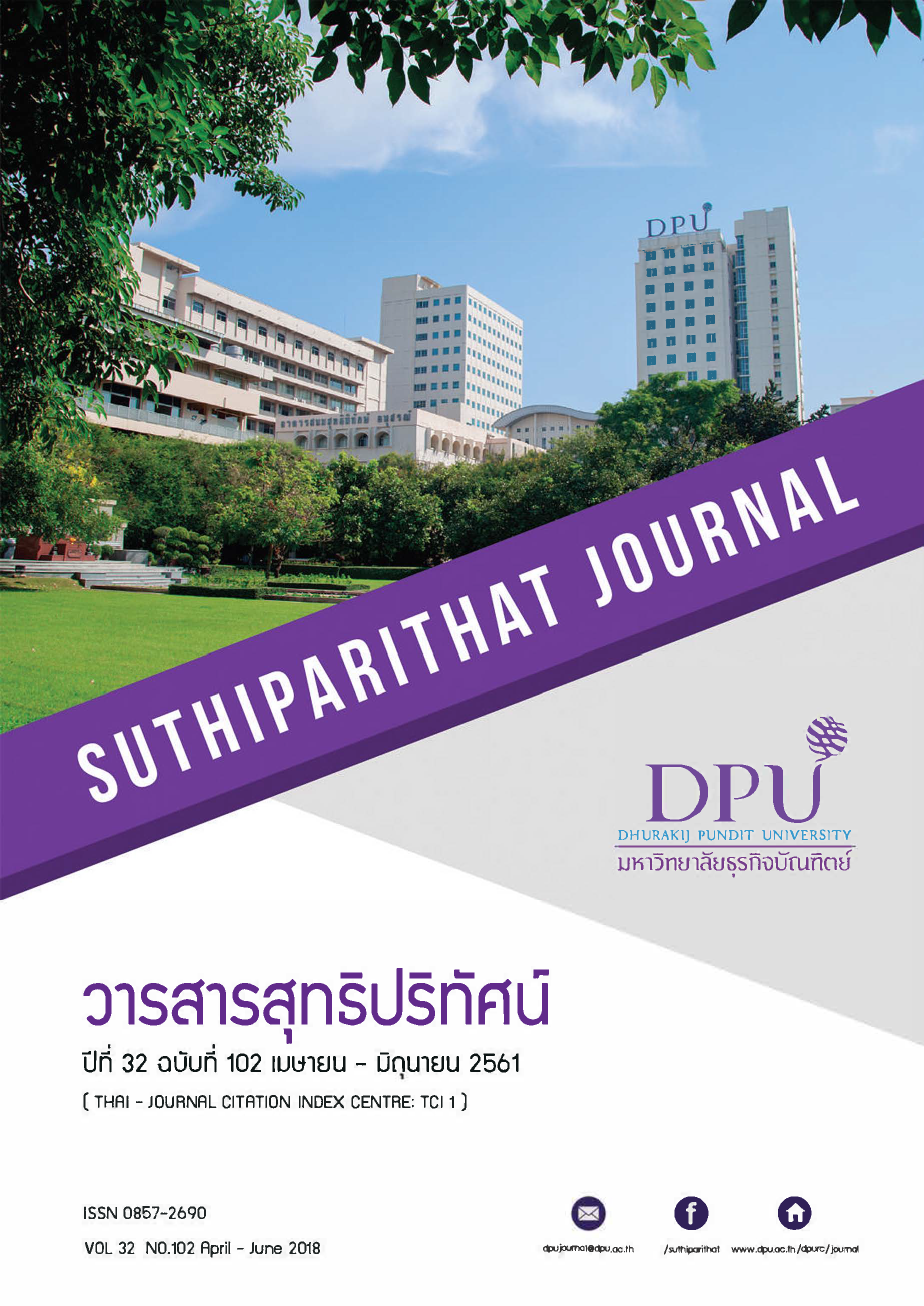อิทธิพลของการรับรู้คุณค่าตราสินค้ากลุ่มยานยนต์ผ่านสื่อสังคมออนไลน์ที่มีผลต่อคุณค่าของการแบ่งปันทางอิเล็กทรอนิกส์และความผูกพันตราสินค้าของผู้บริโภค
คำสำคัญ:
สื่อสังคมออนไลน์, ภาพลักษณ์ตราสินค้า, ความไว้วางใจตราสินค้า, ความผูกพันตราสินค้า, คุณค่าของการแบ่งปันทางอิเล็กทรอนิกส์, การรับรู้คุณค่าตราสินค้าบทคัดย่อ
การวิจัยครั้งนี้มีวัตถุประสงค์(1)เพื่อศึกษารูปแบบการรับรู้คุณค่าตราสินค้าผ่านสื่อโฆษณาสังคม ออนไลน์ ที่มีผลต่อคุณค่าของการแบ่งปันอิเล็กทรอนิกส์ และความผูกพันตราสินค้า และ(2) เพื่อตรวจสอบ ความสอดคล้องของโมเดลเชิงสาเหตุอิทธิพลของการรับรู้คุณค่าตราสินค้าผ่านสื่อโฆษณาสังคมออนไลน์ ภาพลักษณ์ตราสินค้า ที่มีต่อความไว้วางใจตราสินค้า คุณค่าของการแบ่งปันอิเล็กทรอนิกส์ และความผูกพัน ตราสินค้า การศึกษาครั้งนี้เป็นการวิจัยเชิงปริมาณ โดยใช้วิธีการสำรวจจากแบบสอบถามกับกลุ่มตัวอย่าง ซึ่งเป็นนักศึกษาระดับอุดมศึกษาในเขตกรุงเทพมหานครจำนวน 400 คน
ผลการทดสอบสมมติฐานจากสมการเชิงโครงสร้างพบว่า การรับรู้คุณค่าตราสินค้าผ่านสื่อสังคม ออนไลน์(เฟซบุ๊กและไลน์) มีอิทธิพลต่อความไว้วางใจตราสินค้า ภาพลักษณ์ตราสินค้ามีอิทธิพลต่อความไว้ วางใจตราสินค้าและคุณค่าของการแบ่งปันอิเล็กทรอนิกส์ ความไว้วางใจตราสินค้ามีอิทธิพลต่อคุณค่าของ การแบ่งปันอิเล็กทรอนิกส์และความผูกพันตราสินค้า ส่วนการรับรู้คุณค่าตราสินค้าผ่านสื่อสังคมออนไลน์ (ยูทูบและอินสตาแกรม) ไม่มีอิทธิพลต่อความไว้วางใจตราสินค้า
เอกสารอ้างอิง
กรุงเทพธุรกิจ. (2560). มาร์เก็ตติ้ง 4.0 ยุคแห่งวิวัฒน์การตลาดเพื่อปวงชน. สืบค้น 20 กันยายน 2560, จาก http://www.bangkokbiznews.com/news/detail/729256
กัลยา วาณิชย์บัญชา. (2549). การใช้ SPSS for Windows ในการวิเคราะห์ข้อมูล. กรุงเทพฯ: ธรรมสาร.
ศิวฤทธิ์ พงศกรรังศิลป์. (2546). การโฆษณาและการส่งเสริมการตลาด. กรุงเทพฯ: ท้อป.
สมาคมดิจิทัลแห่งประเทศไทย. (2559). สมาคมโฆษณาดิจิทัล (ประเทศไทย) มั่นใจเม็ดเงินโฆษณาดิจิทัลปี 2560 ทะลุหนึ่งหมื่นล้านบาท. สืบค้น 3 ตุลาคม 2560, จาก http://www.daat.in.th/index.php/digitaladvertising2017/
Aaker, D. A. (1991). Managing brand equity: Capitalizing on the value of a brand name. New York: Free Press.
Abdullah, A. (2015). Perceived Quality, Brand Image and Brand Trust as Determinants of Brand Loyalty. Journal of Research in Business and Management. 3(4), 1-8
Achmad , Y., Alif F., Djumilah , H., & Sit, A. (2014). The influence of brand image on purchase behavior through brand trust. Business Management and Strategy, 5(2), 58-76
Belch, G. E., & Belch, M. A. (2009). Advertising and promotion: An integrated marketing communications perspective (8th ed.). Singapore: McGraw Hill/Irwin
Cochran, W. G. (1977) . Sampling Techniques. (3d ed). New York: John Wiley and Sons Inc.
Ercis, A. (2012). The effect of brand satisfaction, trust and brand commitment on loyalty and repurchase intentions. Social and Behavioral Sciences, 58, 1395 – 1404.
Fill, C. (2009). Marketing communications: Interactivity, communities and content. New Jersey: Prentice Hall.
Kotler, P. (2003). Marketing management (11th ed.). Upper Saddle River, NJ: Prentice-Hall.
Lake, L. (2015). Word of Mouth vs. Viral Marketing: What’s the Difference? Retrieved October 25, 2017, from http://marketing.about.com/od/marketingmethods/a/womvsviral.htm
Mollen, A., & Wilson, H. (2010). Engagement, telepresence and interactivity in online consumer experience: Reconcilling scholastic and managerial perspectives. Journal of Business Research, 63, 919-925.
Randell, R. (1996). Home health care nursing: Practice concepts & application (2nd ed.). Philadelphia: Mosby Year Book.
Richard , C., Loury , O., & David , P. (2013). The impact of product quality on perceived value, trust and students’ intention to purchase electronic gadgets. Mediterranean Journal of Social Sciences, 4(14).
Ryan, D & Jones, C. (2011). Understanding digital marketing : marketing strategies for engaging the digital generation. London: Kogan Page.
Sanghyun, K., & Hyunsun, P. (2013). Effects of various characteristics of social commerce (s-commerce) on consumers’ trust and trust performance. International Journal of Information Management, 33(2), 318-332.
Sara, S. & Hamidreza, H. A. (2016). Investigating the impact of brand love, brand image, excitement and word of mouth on consumers. International Journal of Information Research and Review, 3(11), 3081-3085
Schiffman L. G., & Kanuk L. L. (2007). Consumer behavior (10thed.). NewYork: Prentice Hall.
Sirdeshmukh, D., Singh, J., & Sabol, B. (2002). Consumer trust, value, and loyalty in relational exchanges. Journal of Marketing, 66(1), 15–37
Strauss, J., Frost, R., & Ansary, A.I. (2009). E-marketing (5th ed.). New Jersey: Prentice Hall.
Svensson, G. (2001). Extending trust and mutual trust in business relationships towards a synchronised trust chain in marketing channels. Management Decision, 39(6), 431-440.
Svensson, G. (2006). Multiple informants and asymmetric interactions of mutual trust in dyadic business relationships. European Business Review, 18(2), 132-152.
ดาวน์โหลด
เผยแพร่แล้ว
รูปแบบการอ้างอิง
ฉบับ
ประเภทบทความ
สัญญาอนุญาต
เนื้อหาและข้อมูลในบทความที่ลงตีพิมพ์ในวารสารสุทธิปริทัศน์ ถือเป็นข้อคิดเห็นและความรับผิดชอบของผู้เขียนบทความโดยตรงซึ่งกองบรรณาธิการวารสาร ไม่จำเป็นต้องเห็นด้วย หรือร่วมรับผิดชอบใด ๆ
บทความ ข้อมูล เนื้อหา รูปภาพ ฯลฯ ที่ได้รับการตีพิมพ์ในวารสารสุทธิปริทัศน์ ถือเป็นลิขสิทธิ์ของวารสารสุทธิปริทัศน์หากบุคคลหรือหน่วยงานใดต้องการนำทั้งหมดหรือส่วนหนึ่งส่วนใดไปเผยแพร่ต่อหรือเพื่อกระทำการใด ๆ จะต้องได้รับอนุญาตเป็นลายลักษณ์อักษรจากวารสารสุทธิปริทัศน์ก่อนเท่านั้น







